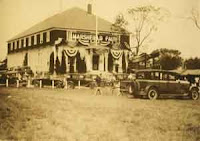Tomorrow (Saturday)
afternoon, my wife, Betty, will deliver a horticultural lecture on the topic of
‘Water-Smart Gardening’. In and of
itself, that’s not an unusual event; Betty will give dozens of talks on
horticultural topics to groups over the next twelve months. But this one will be unusual. Instead of a garden club or environmental
organization, Betty’s audience will be people attending the Marshfield Fair. They’ll come into the Agriculture Building
because they saw a sign outside it advertising a talk. With luck, they’ll leave with a large dollop
of education.
 |
| I have nothing against fair food, but it's not why I go |
I’ve had the pleasure to contribute
at the periphery of the Marshfield Fair for the past few years. Rather than the one most people think of when
they such events (deep-fried Snickers bars, Tilt-a-Whirl rides), the one I love
exists in an alternate universe; it harkens back to the original Marshfield
Agricultural & Horticultural Society. I don’t begrudge fair-goers the
thrill of the Midway, but I think my fair is a lot more fun.
 |
| Agricultural Hall in the 1920s... |
New England lives in a
state of grace when it comes to fairs. Once upon a time, agricultural
expositions were a staple around the country. The Marshfield Fair, for
example, got its start in 1862 when three local farmers formed what was then
called the Farm and Garden Group to discuss ways to improve farming. By
1866, returning war veterans going back to farming needed a means of pooling
their ideas and formed the South Marshfield Farmer’s Club. A year later,
the club’s annual summer event had grown so large it was attracting the
manufacturers of agricultural implements, while club members showed off their
best farm animals and produce. By 1869, a piece of land had been
purchased for a permanent exhibition site and a fine building, Agricultural
Hall, was under construction. In the following decades, the Marshfield
Fair ruled the South Shore of Massachusetts.
 |
| ... and today. |
Here’s a description of the
fair, circa 1890: “Before the children saw the flag even, they often
heard the band. Coming through the pinewoods, by train, by horse-drawn carriage
of every description, and on foot, just before they emerged into sight of the
Fair grounds, they heard that joy-thrilling music of the brass band. Here was
where Fair really began. Anticipation had reached its height and was soon to
give way to the actual joys of Cattle Show. And reality can never touch
anticipation…”
 |
| I had an exhibit at this year's fair... |
Remarkably, a number of
expositions that still look and feel a lot like their century-ago forebears
have survived in New England. In addition to the Marshfield Fair, the Woodstock Fair in Connecticut traces its origins to 1860 and
will be held over Labor Day Weekend, September 1-4. The Fryeburg Fair in Maine dates to 1851 and will be open this year from October 1 to
October 8. And the granddaddy of them all, the Topsfield Fair, which held its first event in 1818, opens September
29 for an eleven-day run.
 |
| Quilts and crafts at the Fair |
I spend the bulk of my time
at the Marshfield Fair inside that venerable Agriculture Building.
Upstairs, there are displays of quilts; some quite old and others brand
new. There were hand-knitted sweaters – not for sale but, rather,
submitted for judging in hopes of securing a blue ribbon. The whole floor
is a tribute to creativity and skill with fabric.
 |
| Flower Show entries |
 |
| There is whimsy all around you |
There are competitions to
design a small grouping of container gardens and another for holiday mantel
arrangements. There is a horticultural competition for the school-aged
set and categories for flower arrangements in purses, watering cans, and
recycled objects. In short, the competitions going on within Horticulture
is about skill and creativity.
 |
| Where else can you see a butterfly hatch before your eyes? |
A quick look around one corner of the Fair
If you live in New England
and have given up on fairs as corny relics, it’s time to give them another
look. And, if you’re thinking of a vacation in New England this fall,
keep in mind the dates of those upcoming ones.
